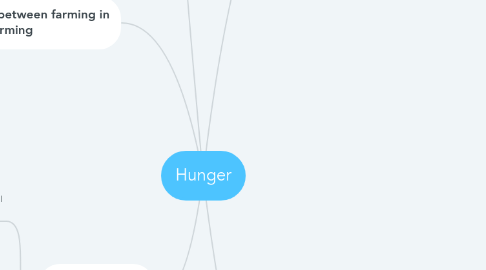
1. facts
1.1. Uneven disitribution of food
1.1.1. some people are eligible for food
1.1.2. mainly uptaked by wealthy countries
1.1.3. some crops are not used as food
1.1.4. farmers are growing too many crops
1.2. types of food
1.2.1. good nutrition means having the right combination of nutrients & calories
1.2.2. vulnerable groups:infant,pregnant woman,young children
1.3. population of food crises
1.3.1. inked to human causes has more than doubled since 1992
1.3.2. conflict is often at the heart of today's wprst food crises
1.4. Access
1.4.1. people from poor countries can't gei to local market
2. differences between farming in china and farming
2.1. size of agricultural industry
2.1.1. china:37%
2.1.2. USA 8%
2.2. Income gap
2.2.1. China:3times
2.2.2. USA:<1times
2.3. income
2.3.1. small sized farming:low,very likely to be loan-being
2.3.2. Large size farming:high-its large supply helps dominiating the market
2.4. made of production
2.4.1. small sized farming:backward,labour intensive
2.4.2. mass production
2.4.2.1. merchanized
3. difficulties faced by villagers in LDCS
3.1. difficulty in securing financial assistance/loan bearing
3.1.1. need higher farm yields to afford the rising living cost(particular education cost)-->need financial backup to buy land to expand the farm-->diificult to borrow loans from banks due to lack of assets-->either fail to obtain financial assistance or borrow loans with highinterest rate from somewhere else
3.1.1.1. difficult to pay off the loans
3.2. proverty
3.2.1. low return from farming and unstable to afford the cost of living
3.2.2. can't support the education of children-->low education level of the next generation
3.2.3. can only work for low skilled job-->intergeneral proverty
3.3. low soil quality
3.3.1. limits the productivity of crops
3.3.1.1. both quality and quantitu
3.4. lack of financial support
3.4.1. can't expand/etine the farming tools-->limit income growth
4. features among LDCs
4.1. climate change
4.1.1. extreme weather(e.g.flooding,drought,typhoon
4.1.1.1. Frequency,intensity
4.1.1.1.1. crops failure
4.1.2. long term
4.1.2.1. sea level
4.1.2.1.1. 1.soil quality(land degration)2.diseases3.pests
4.1.2.2. temp rises
4.1.2.2.1. 1.soil quality(land degration)2.diseases3.pests
4.1.2.3. precipitation
4.1.2.3.1. water availability becomes unstable
4.1.3. food security
4.1.3.1. food availability
4.1.3.1.1. changes in climatic conditions affect the production of some staple crop
4.1.3.1.2. e.g.Higher temperature will have an impact on yields while changes in rainfall could affect crop quality and quantity
4.1.3.2. food access
4.1.3.2.1. climate change could increase the pricese of major crops due to fall in supply
4.1.3.2.2. lower agricultural output means lower incomes for low income farmers
4.1.3.2.3. lower affordability/less able to get access to food
4.1.3.3. food utilization
4.1.3.3.1. climate related risks affect calorie intake,particularly in areas where chronic food insecurity is already a significant problem
4.1.3.3.2. create a vicious cycle of diseases and hunger
4.1.3.4. food stability
4.1.3.4.1. most frequent and intense extreme weather events can upset the stability of indiviuals' and government food security strategies
4.1.3.4.2. fluctuations in food availability,access and utilization
4.1.4. vulnerability
4.1.4.1. adaptive capacity
4.1.4.1.1. capability of a system to adjust to climate change to moderate potential damage,to take advantage of opportunities,or to cope with the consequences
4.1.4.1.2. e.g.knowledge of climate risk,infrastructure,welfare and non-government support,government policies
4.1.4.2. exposure
4.1.4.2.1. long term changes in climate conditions,or changes in climate variability
4.1.4.2.2. magnitude &frequency of extreme events
4.1.4.3. sensitivity
4.1.4.3.1. the degree to which a system will be affected by,or responsive to climatic stress
4.1.4.3.2. e.g.a community dependent on rain fed agriculture is much more sensitive to changing rainfall patterns than one where mining is the dominant livelihood
5. causes
5.1. economic
5.1.1. lack of investment in the agriculture sector(e.g.seeds,fertilizers,irrigation)
5.1.2. focused on low-input low-output subsistence agriculture instead of production for markets
5.1.3. difficulties faced by farmers in accessing markets due to the poor road network,lack of other transport modes and nuisance taxes and charges,including bribes
5.2. global competition and the lack of a critical mass of farmer and rural producer associations as means of entering the market place with the aim of minimizing the cost of input,accessing loan finance at affordable rates and influencing farm gate prices
5.3. political
5.3.1. civil war destruction
